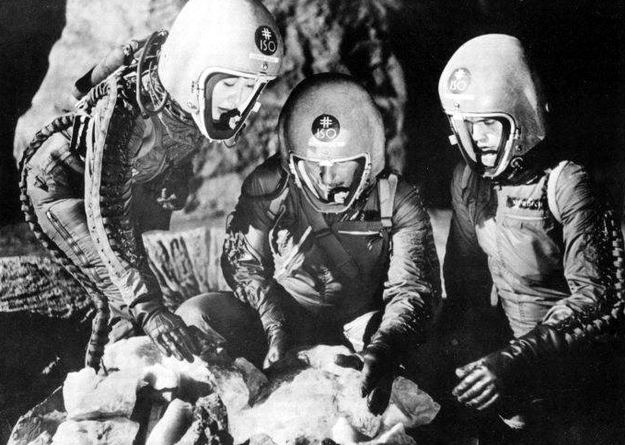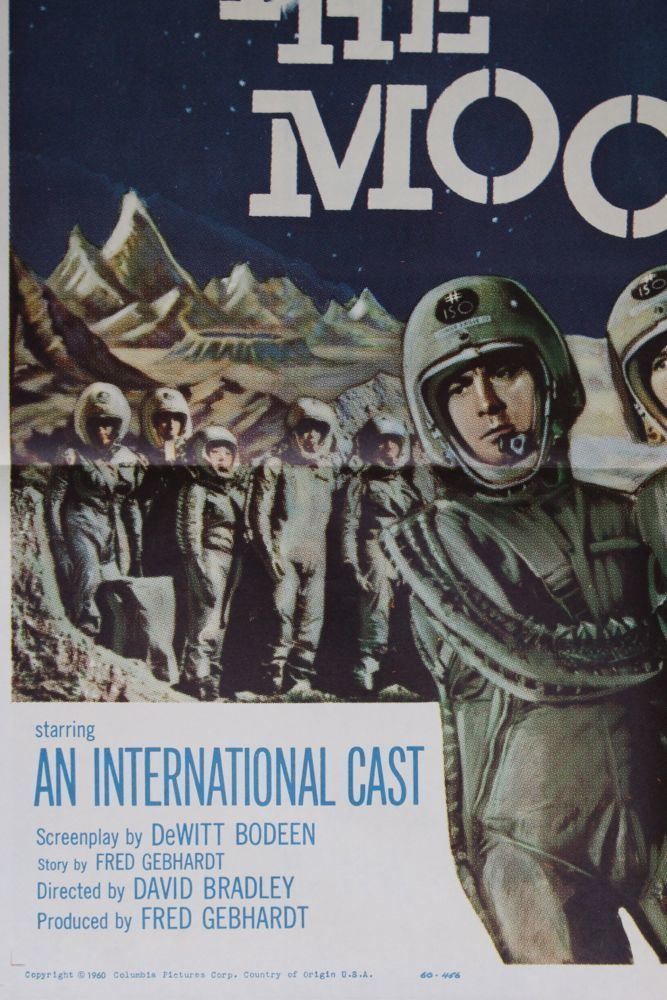12 to the Moon
3 /10 1 Votes
Duration Language English | 2.8/10 IMDb Genre Sci-Fi Country USA | |||||||||||||||||||||||||||||||||
 | ||||||||||||||||||||||||||||||||||
Release date June 1960 (1960-06) Cast (Capt. John Anderson), Michi Kobi (Dr. Hideko Murata), (Dr. Feodor Orloff), (Dr. Luis Vargas), (Dr. Erich Heinrich), Robert Montgomery Jr. (Roddy Murdock)Similar movies Interstellar , The Martian , 2001: A Space Odyssey , Guardians of the Galaxy , Independence Day , Solaris Tagline Ride the Excitement Orbit to the Moon with the First Space Explorers! | ||||||||||||||||||||||||||||||||||
12 to the moon 1960 trailer
12 to the Moon is an independent 1960 American black-and-white science fiction film produced by Fred Gebhardt and directed by David Bradley as Luna Productions Inc. The film depicts the first moon landing, made by an international 12-person crew. On the moon, they encounter hostile but unseen aliens who live beneath the surface and who temporarily encase North America in ice after ordering the astronauts to leave. The astronauts thaw the continent just before they return to earth.The film was distributed theatrically in the US in 1960 on a double bill with either Battle in Outer Space or 13 Ghosts.
Contents

A novelisation of the film, also titled 12 to the Moon, was published in 1961 by Fred Gebhardt under the pen name Robert A. Wise. Gebhardt had written the original story for the film; the movie script was written by DeWitt Bodeen.

Mst3k 524 12 to the moon
Plot
The International Space Order has organised the first manned landing on the moon, with the goal of claiming it as 'international territory'. The crew of spaceship Lunar Eagle 1 comprises 12 people from around the world - 10 men and two women, all scientists with different specialities - accompanied by a small menagerie, including two cats. The ship is commanded by an American, John Anderson (Ken Clark).

Historical and international tensions flare up in-flight. Feodor Orloff (Tom Conway), a Russian, struts about, annoyingly claiming that all scientific advancements were invented by the Soviets. Israeli David Ruskin (Richard Weber) warns Feodor that the USSR would be unwise to attempt to dominate Israel as it has dominated his native Poland. David admires fellow astronaut Erich Heinrich (John Wengraf) but is as yet unaware that Erich's father was the Nazi responsible for murdering David's family during the Holocaust.

After a dangerous 27-hour earth-to-moon flight, Lunar Eagle lands and the crew begin explorations. Sigrid Bomark (Anna-Lisa) and Selim Hamid (Muzaffer Tema) find an air-filled cave and after shedding their space helmets, kiss passionately. As they walk hand-in-hand deeper into the cave, its opening is suddenly sealed by impenetrable ice. They are left behind when the spaceship leaves.

The others find gold and minerals, but when they fire a mortar into a rock formation, liquid begins bubbling out. An excited Feodor rushes over and sticks his hands into the flow. He is badly burnt. On the way back to the ship, a crew member sinks to his death in lunar quicksand. John tries unsuccessfully to save him and almost goes under himself.
Inside Lunar Eagle, a machine begins printing out moon-language hieroglyphics. Surprisingly, Hideko Murata (Michi Kobi) can read them. She says they are a message from 'The Great Coordinator of the Moon', who orders the ship to leave at once. The message says that the emotionless moon-beings live underground and fear that the earthlings will 'contaminate our perfect form of harmony'. Sigrid and Salim are being studied because the moon-beings are unfamiliar with love, although the two and 'all your kind' will be destroyed 'if love turns to evil'. The moon-beings also demand that the cats - which were to be an experiment to see if they could 'procreate' on the moon - be left behind as they find cats as interesting as people.
During Lunar Eagle's blast off, Erich has a heart attack. David learns, as Erich babbles half-conscious, that Erich's father was the Nazi who killed David's family. David forgives Erich and they become friends.
As they near earth, the crew witness 'the big freeze' - a gigantic cloud, controlled from the moon, which encases all of Canada, the U.S. and Mexico in ice.
John decides to drop 'atomic bomblets' into the volcano Popocatepetl to trigger an eruption to thaw North America. Etienne Martel (Roger Til) sabotages the bomblets, revealing himself as a French communist. He assumes that Feodor would also want to keep America frozen forever in order to advance international communism's quest for world domination. Feodor doesn't. He and Etienne fight, Feodor calls to John for help, and when Etienne unfairly pulls out a knife, John knocks him down. Feodor repairs the bomblets.
Erich and David fly a suicide mission to drop the bomblets from the ship's 'space taxi'. Popocatepetl erupts; North America thaws. Another message from the moon says that the moon-beings now realise that earthlings are honourable and peaceful, and that the North Americans were put into suspended animation before the big freeze, so no-one has been harmed. Moreover, earthlings will be welcomed to the moon when they someday return.
Following the great thaw, Lunar Eagle's triumphant crew prepare to land.
Cast
Production
12 to the Moon was in production during April, May and June 1959 at the California Studios in Hollywood. The actual filming took seven or eight days and the entire movie was budgeted at $150,000. Although it wasn't released to theatres for another year, the American Film Institute notes that 'According to an Oct 1959 HR [Hollywood Reporter] news item, Columbia purchased the independent production in Aug 1959, intending to rush it into release to capitalise on the topicality of a space launch'.
Release
The film premiered in Los Angeles on 22 June 1960. Columbia Pictures handled the theatrical release in the US and the UK during 1960. It opened in Mexico on 23 February 1961 and was also shown in Australia at an unspecified date.
For individual home viewing, 12 to the Moon was released in the US on 2011 on DVD by Sony Home Entertainment. Mill Creek Entertainment released it on DVD as part of its Vintage Sci-Fi 6 Movie Collection in 2015, and Shout! Factory followed in 2016 with a DVD of the version shown on Mystery Science Theater 3000. The film was featured on MST3K on 5 February 1994, during the programme's fifth season.
Reception
The critics of 1960 generally found the film to be, in the words of British film critic Phil Hardy, 'a decidedly minor offering, the presence of [DeWitt] Bodeen (writer of Cat People, 1942) and [John] Alton, one of Hollywood's unsung cinematographic geniuses, notwithstanding'. 'Kobe', writing in the 22 June 1960 issue of Variety, called 12 to the Moon a 'Lower-half science-fantasy item in which a dozen good eggs from earth tangle with some righteous, but misdirected, luna-tics. Timely, but crude and cliché-ridden'. 'Kobe', however, also praised Alton's camerawork. The anonymous reviewer in BoxOffice referred to the film as 'A modest science fiction programmer [which] will satisfy the youngsters and the action fans who delight in stories of rocketships to the moon'. The magazine gave the film a rating of 'fair' on its poor-to-very-good scale. According to Bill Warren, the American science-fiction film critic and historian, the Monthly Film Review said the movie was a 'juvenile piece of hokum' with 'only its special effects and weird lunar landscape to recommend it', although Kinematograph Weekly in the UK found more merit, calling 12 to the Moon 'Extravagant and intriguing [with a] fascinating subject, sound acting [and] resourceful technical presentation'.
While modern-day critics have called the film 'extremely strange and unpredictable', relatively little appears to have been written about the international status of the astronauts and the bearing it has on the plot. American film critic Gary Westphal points out that the 'unusually large crew of twelve [is] said to represent twelve different countries' - Brazil, France, Germany, Great Britain, Israel, Japan, Nigeria, Poland, Russia, Sweden, Turkey and the US - which indicates that the journey is 'motivated primarily by a desire "to prevent national disputes" arising over the Moon in particular and, one infers, other subjects in general'. However, as Warren points out, 'each person acts in accordance with national stereotypes and has virtually no other characterisation'.
Modern critics have also taken the movie to task for its special effects. For example, Westphal writes that the space helmets have no visors, but each is instead equipped with an 'invisible electromagnetic ray screen' that protects the astronauts' faces. He speculates that the obviously missing visors were perhaps not noticed until late in the filming and that a scene which explains the ray screens was inserted prior to the film's release, before audiences could wonder about it. Bryan Senn, also an American critic, notes that 'The effects are minimal and substandard, consisting mainly of the same shot of a rocket travelling through space used over and over again (and it's not even a convincing shot - the stars shine right through the transparent-looking ship)', although he calls the moon set 'eerie and effectively alien, with its cracks, weird shadows, and smoke seeping from mysterious holes'. Warren points out that the earth-saving eruption of Popocatepetl is 'depicted by stock footage of solar prominences' that bear little resemblance to real volcanic eruptions.
Modern critics are also bothered by the narrative development of the film. Westphal says that 'Few films ... begin as soberly, and end as absurdly, as 12 to the Moon. The film's first thirty minutes promise an internationalised update of Destination Moon [1950], while later events rival a Flash Gordon serial'. Senn agrees that the film is disappointing, noting that 'What starts out as a fairly intelligent and progressive space-travel film ... quickly degenerates into a juvenile, simplistic space opera. Admittedly, space operas have their place, but 12 to the Moon fails to deliver even a single aria, much less the whole opera'.
References
12 to the Moon Wikipedia12 to the Moon IMDb 12 to the Moon themoviedb.org
